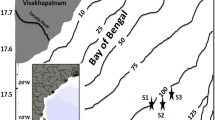Abstract
We analysed quantity and quality of particulate organic matter during the austral summer 1994/1995 at a coastal station in Terra Nova Bay (Ross Sea, Antarctica). Our main aims were to investigate the origin and biochemical composition of particulate organic matter (POM), to measure its availability for consumers through the study of its digestible fraction (measured by using different enzymes separately) and to highlight the role of hydrolizable compounds in the organic matter diagenesis in the coastal waters at Terra Nova Bay. Temporal and spatial patterns of chlorophyll-a concentrations were reflected by the particulate organic carbon, nitrogen and total biopolymeric carbon concentrations, suggesting that most POM originated directly from phytoplankton. The most evident feature of POM in the coastal waters at Terra Nova Bay was the dominance of proteins (on average 57% of total biopolymeric particulate carbon), followed by carbohydrates (25%) and lipids (18%). We found that about 30% of the refractory particulate organic carbon (assumed to be present only after the complete exploitation of particulate organic nitrogen) did not originate from biopolymeric carbon (as sum of carbohydrate, protein and lipid carbon). This allows us to suggest the use of the digestible fraction of particulate biopolymeric carbon as a more accurate measure of the food availability of POM for consumers. In Terra Nova Bay coastal waters, most of the particulate protein pool was associated with large phytoplankton cells or phytodetritus. As a result, the protein pool appeared less available (i.e. less digestible) than the one present in oligotrophic waters where, conversely, most particulate organic nitrogen is sequestered into bacteria. The relative low availability of the protein pool, together with the rapid sinking of POM and the low remineralization rates of benthic heterotrophic microbes, are suggested as possible factors in determining the “inefficiency” in organic matter recycling of coastal waters at Terra Nova Bay, which behaves as a “loss type” system.
Similar content being viewed by others
Author information
Authors and Affiliations
Additional information
Received: 17 June 1997 / Accepted 25 September 1997
Rights and permissions
About this article
Cite this article
Fabiano, M., Pusceddu, A. Total and hydrolizable particulate organic matter (carbohydrates, proteins and lipids) at a coastal station in Terra Nova Bay (Ross Sea, Antarctica). Polar Biol 19, 125–132 (1998). https://doi.org/10.1007/s003000050223
Issue Date:
DOI: https://doi.org/10.1007/s003000050223




